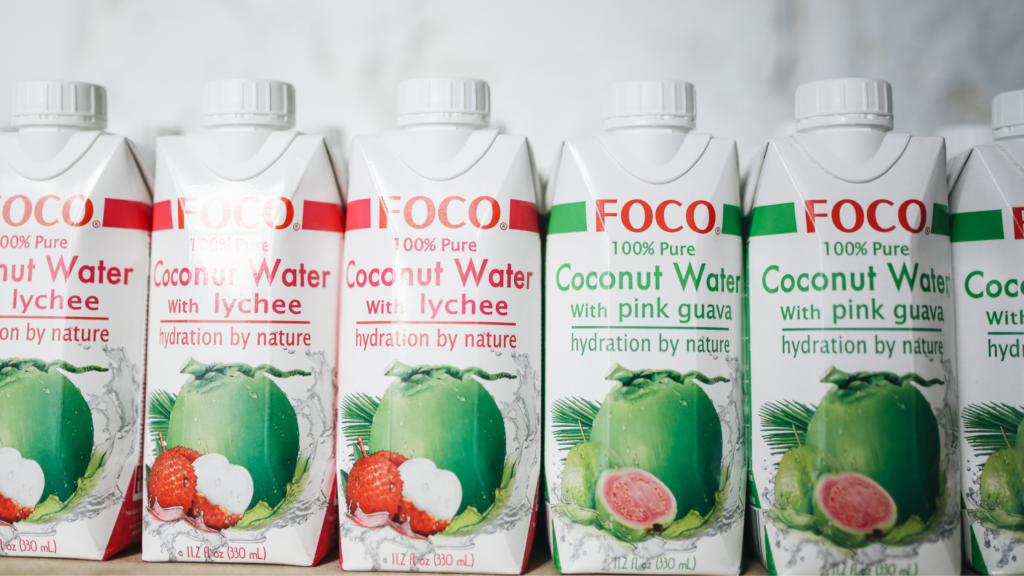Coconut water has surged in popularity in recent years for its hydrating properties and unique taste. Derived from young green coconuts, this natural beverage is not just a tropical delight but also a source of various health benefits.
So does coconut water go bad?
In short, the answer is a simple yes – but with that said there are a number of factors that can and will affect the shelf life of coconut water.
6 Key Factors That Will Determine the Freshness of Your Coconut Water
The shelf life of coconut water can be influenced by various factors, and understanding these elements is crucial to ensuring its freshness. Here are key factors that can affect how long coconut water remains palatable:
- Packaging: The type of packaging plays a significant role in determining the shelf life of coconut water. Sealed and airtight containers, like vacuum-sealed bottles, can protect the contents from external contaminants and prevent exposure to air, helping to extend the shelf life.
- Storage Conditions: Temperature and storage conditions are critical factors. Coconut water is best stored in a cool, dark place away from direct sunlight. Exposure to heat and light can accelerate the deterioration of the product. Refrigeration can further slow down the natural degradation process, preserving the freshness of the coconut water.
- Exposure to Air: Once opened, coconut water becomes susceptible to airborne bacteria and oxidation. The introduction of air into the container can lead to the growth of microorganisms and changes in the flavor and quality of the coconut water. Sealing the container tightly after each use can help minimize air exposure.
- Quality of Coconuts: The quality of the coconuts used in the extraction process influences the shelf life of coconut water. Fresh and high-quality coconuts contribute to a better-tasting and longer-lasting product. If the coconuts used are already compromised or overripe, the resulting coconut water may have a shorter shelf life.
- Additives and Preservatives: Some commercially available coconut water products may contain additives or preservatives to extend their shelf life. These can include natural preservatives like ascorbic acid (vitamin C) or citric acid. Understanding the ingredients list can provide insights into the potential shelf life of a specific coconut water product.
- Pasteurization: Pasteurization, a heat treatment process, is often employed to kill harmful microorganisms and bacteria in coconut water. This process can contribute to an extended shelf life by inhibiting the growth of spoilage-causing agents. However, pasteurized coconut water may have a slightly different taste compared to fresh, unpasteurized varieties.
By considering these factors, consumers can make informed choices about how to store and select coconut water to maximize its shelf life and enjoy its benefits over an extended period.
Can You Tell if Your Coconut Water Has Spoiled?

There are a handful of guidelines that can help you detect whether your coconut water has gone bad or not.
Understanding Expiration Dates
One key aspect of determining whether coconut water has gone bad is to pay attention to the expiration date on the packaging. Manufacturers provide this date as an indicator of the period during which the product is expected to remain at its best quality. It is advisable to consume coconut water before the expiration date to ensure optimal taste and freshness. However, it’s essential to note that the expiration date is not the sole factor to consider, and other signs of spoilage should be taken into account.
Changes in Color, Taste, and Odor
Coconut water, when fresh, typically exhibits a clear and slightly cloudy appearance. Any significant changes in color, such as a shift towards a murky or off-color tone, may indicate spoilage. Similarly, alterations in taste and odor can be indicative of coconut water going bad. Fresh coconut water has a mildly sweet and nutty flavor. If you notice a sour or fermented taste, or if the aroma is unpleasant or rancid, these are clear signs that the coconut water has deteriorated.
Presence of Mold or Particles
Visual cues can provide valuable information about the freshness of coconut water. Inspect the liquid for the presence of mold, unusual particles, or cloudiness. Mold growth, in particular, is a clear indication of spoilage. Additionally, if you observe any foreign particles floating in the coconut water, it’s a signal that contaminants may have entered the container, compromising its quality. In such cases, it’s advisable to discard the coconut water to avoid potential health risks.
While expiration dates offer guidance, it’s equally important to trust your senses. Changes in color, taste, and odor, as well as the presence of mold or particles, serve as reliable indicators of whether coconut water has gone bad. By being vigilant and attentive to these factors, consumers can make informed decisions about the freshness and safety of the coconut water they consume.
